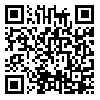Volume 13, Issue 3 (Summer-In Press 2025)
PCP 2025, 13(3): 0-0 |
Back to browse issues page
Download citation:
BibTeX | RIS | EndNote | Medlars | ProCite | Reference Manager | RefWorks
Send citation to:



BibTeX | RIS | EndNote | Medlars | ProCite | Reference Manager | RefWorks
Send citation to:
motevasselian S, Jafari Kadijani N. Investigating the Relationship Between Attachment Styles and Responsibility in Adolescents Based on the Mediating Role of Emotion Regulation. PCP 2025; 13 (3)
URL: http://jpcp.uswr.ac.ir/article-1-967-en.html
URL: http://jpcp.uswr.ac.ir/article-1-967-en.html
1- Department of Psychology, Faculty of Literature and Humanities, North Tehran Branch, Islamic Azad University, Tehran, Iran.
2- Department of Psychology, Faculty of Literature and Humanities, North Tehran Branch, Islamic Azad University, Tehran, Iran. ,Dr.jafarik7@gmail.com
2- Department of Psychology, Faculty of Literature and Humanities, North Tehran Branch, Islamic Azad University, Tehran, Iran. ,
Abstract: (55 Views)
Background and Objectives: This study examines the relationships between attachment styles and responsibility in male and female adolescents while considering the mediating role of emotion regulation.
Methods: This study employed a descriptive-correlational research design using path analysis. Our statistical population comprised all high school students (second level) in Tehran City, Iran. Following Kline's (2016) recommendations, 353 students were selected through random sampling of the multi-stage cluster. Assessment tools included the revised adult attachment scale, the emotion regulation questionnaire for children and adolescents, and the personal responsibility assessment. The data were analyzed using the AMOS software, version 24.0, with maximum likelihood estimations.
Results: The findings revealed a positive and significant indirect path coefficient between secure attachment style and responsibility through reappraisal strategies (β = 0.105, P = 0.001) and suppression (β = 0.091, P = 0.001). The indirect path coefficient between avoidant attachment style and responsibility through reappraisal strategies (β = -0.099, P = 0.001) and suppression (β = -0.068, P = 0.007) showed negative and significant associations. Similarly, the indirect path coefficient between ambivalent attachment style and responsibility through reappraisal strategies (β = -0.105, P = 0.001) and suppression (β = -0.065, P = 0.012) demonstrated negative and significant relationships.
Conclusion: The structural model exhibited an equivalent fit for both male and female groups. Attachment style significantly influences adolescents' responsibility, and emotion regulation and management contribute to increased responsibility in adolescents.
Methods: This study employed a descriptive-correlational research design using path analysis. Our statistical population comprised all high school students (second level) in Tehran City, Iran. Following Kline's (2016) recommendations, 353 students were selected through random sampling of the multi-stage cluster. Assessment tools included the revised adult attachment scale, the emotion regulation questionnaire for children and adolescents, and the personal responsibility assessment. The data were analyzed using the AMOS software, version 24.0, with maximum likelihood estimations.
Results: The findings revealed a positive and significant indirect path coefficient between secure attachment style and responsibility through reappraisal strategies (β = 0.105, P = 0.001) and suppression (β = 0.091, P = 0.001). The indirect path coefficient between avoidant attachment style and responsibility through reappraisal strategies (β = -0.099, P = 0.001) and suppression (β = -0.068, P = 0.007) showed negative and significant associations. Similarly, the indirect path coefficient between ambivalent attachment style and responsibility through reappraisal strategies (β = -0.105, P = 0.001) and suppression (β = -0.065, P = 0.012) demonstrated negative and significant relationships.
Conclusion: The structural model exhibited an equivalent fit for both male and female groups. Attachment style significantly influences adolescents' responsibility, and emotion regulation and management contribute to increased responsibility in adolescents.
Type of Study: Original Research Article |
Subject:
Rehabilitation
Received: 2024/11/26 | Accepted: 2025/04/13 | Published: 2025/07/11
Received: 2024/11/26 | Accepted: 2025/04/13 | Published: 2025/07/11
| Rights and permissions | |
 |
This work is licensed under a Creative Commons Attribution-NonCommercial 4.0 International License. |







